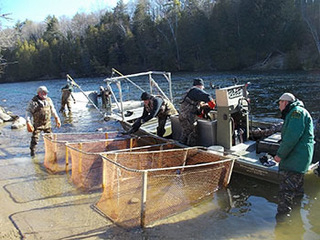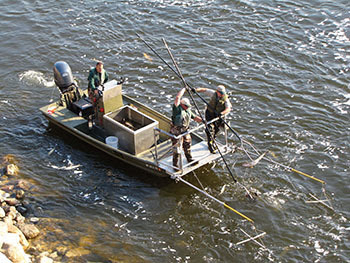Michigan: DNR Collecting Walleye Eggs on Muskegon River This Spring

Muskegon River anglers should be on the lookout for Michigan Department of Natural Resources personnel collecting walleye eggs below Croton Dam this spring.
Walleye will be collected with electrofishing boats starting as early as the week of March 20 and concluding by April 14. The date these collections begin will depend on water temperatures, the presence of ripe fish and other factors. It is anticipated most work will be completed from the last week of March through the first week of April. Five days of electrofishing are planned, with four of those being egg-take days.
“This adult population consists of mostly stocked fish,” said Ed Pearce, DNR fisheries technician supervisor who coordinates the egg take. “The Muskegon River has the largest run of walleye in the Lake Michigan watershed south of Green Bay.”
Electrofish sampling usually begins at Croton Dam each day at about 8:30 a.m. and proceeds downstream to the Pine Street access site. If more eggs are needed, additional collections may occur downstream to the Thornapple Street access site.
Anglers who wish to avoid the walleye collection activities should fish downstream of the Pine Street access site. The DNR asks everyone to use caution when fishing near the electrofishing boats, and those wading will be asked to exit the water when a boat approaches and during electrofishing work.
The DNR also asks the public to not gather at egg collection to allow DNR staff to maintain effective social distancing and to safely and efficiently collect eggs. The DNR appreciates cooperation during this critical egg-take operation.
The DNR plans to collect approximately 24 million walleye eggs from the Muskegon River this year, which will result in fry (fish that have just hatched) for transfer to rearing ponds and direct fry plants throughout the Lower Peninsula. Walleye fry transferred to ponds will be raised to fingerling size (approximately 1.5 to 2.5 inches) and stocked in late spring or early summer in lakes and rivers throughout the Lower Peninsula. Lake Michigan and many inland lake walleye populations in the Lower Peninsula depend on the fingerlings produced from Muskegon River eggs.
The size of the walleye spawning run in the Muskegon River is about 40,000 to 50,000 fish each year. DNR crews will strip milt (sperm) and eggs from approximately 350 adult fish, which will be returned to the river – except for 60, which will be sent to Michigan State University for fish health testing.
Learn more about how the DNR manages Michigan’s fisheries at Michigan.gov/Fishing.
Contact: Mike Wilson, 269-204-7058 or Sierra Williams, 517-230-8788





